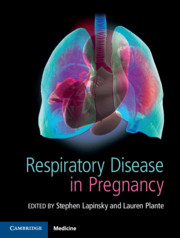Book contents
- Respiratory Disease in Pregnancy
- Respiratory Disease in Pregnancy
- Copyright page
- Contents
- Contributors
- Section 1 The Basics: for the Obstetrician
- Section 2 The Basics: for the Non-Obstetrician
- Section 3 Pulmonary Conditions Not Specific to Pregnancy
- 6 Pulmonary Infections in Pregnancy
- 7 Asthma in Pregnancy
- 8 Cystic Fibrosis in Pregnancy
- 9 Restrictive Lung Disease in Pregnancy
- 10 Thromboembolic Disease in Pregnancy
- 11 Pulmonary Hypertension and Pregnancy
- 12 Sickle Chest Syndromes in Pregnancy
- 13 Sleep-disordered Breathing in Pregnancy
- 14 Acute Respiratory Distress Syndrome in Pregnancy
- 15 Other Pulmonary Conditions in Pregnancy: Pleural Disease, Haemoptysis and Air Embolism
- Section 4 Pulmonary Conditions Related to Pregnancy
- Section 5 Other Pulmonary Issues in Pregnancy
- Index
- References
10 - Thromboembolic Disease in Pregnancy
from Section 3 - Pulmonary Conditions Not Specific to Pregnancy
Published online by Cambridge University Press: 14 April 2020
- Respiratory Disease in Pregnancy
- Respiratory Disease in Pregnancy
- Copyright page
- Contents
- Contributors
- Section 1 The Basics: for the Obstetrician
- Section 2 The Basics: for the Non-Obstetrician
- Section 3 Pulmonary Conditions Not Specific to Pregnancy
- 6 Pulmonary Infections in Pregnancy
- 7 Asthma in Pregnancy
- 8 Cystic Fibrosis in Pregnancy
- 9 Restrictive Lung Disease in Pregnancy
- 10 Thromboembolic Disease in Pregnancy
- 11 Pulmonary Hypertension and Pregnancy
- 12 Sickle Chest Syndromes in Pregnancy
- 13 Sleep-disordered Breathing in Pregnancy
- 14 Acute Respiratory Distress Syndrome in Pregnancy
- 15 Other Pulmonary Conditions in Pregnancy: Pleural Disease, Haemoptysis and Air Embolism
- Section 4 Pulmonary Conditions Related to Pregnancy
- Section 5 Other Pulmonary Issues in Pregnancy
- Index
- References
Summary
Venous thromboembolism (VTE), which manifests as deep venous thrombosis (DVT) and pulmonary embolism (PE), is a major cause of maternal morbidity in developed countries, with an estimated overall incidence of 12.1 per 10 000 and 5.4 per 10 000 pregnancies, respectively.
- Type
- Chapter
- Information
- Respiratory Disease in Pregnancy , pp. 90 - 98Publisher: Cambridge University PressPrint publication year: 2020



